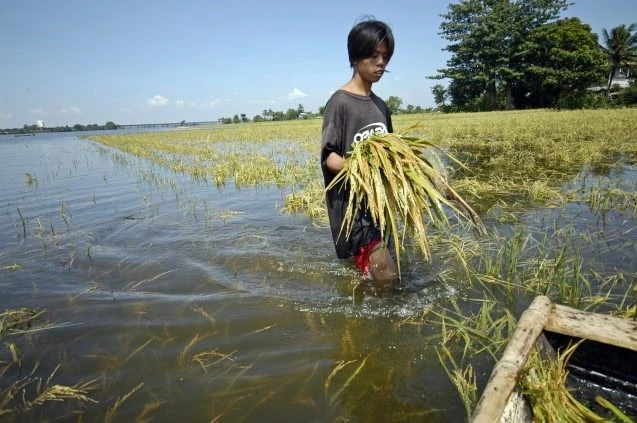By: Thinn Nay Chi Sun
The agriculture sector is Myanmar’s main industry producing 23% of the country’s gross domestic product. With two-thirds of the population depending on it, the sector provides 70% of national employment. 51% of women who are members of households also depend on agriculture.
Climate and Agriculture
Myanmar is among the most natural disaster-prone countries in Asia. Annually, it is exposed to floods, earthquakes, cyclones, tsunamis, and landslides. Climate change will likely increase the risks posing a bigger threat to the livelihoods of farmers. The country’s economy is dependent on agriculture which is highly reliant on the amount of rainfall the country is experiencing. Too much rain will cause floods while little or no rain will bring droughts. The two phenomena are influencing factors on the production of crops and will in one way or another, have negative effects on the sector.
Impact on livelihoods
A joint report by the Myanmar Government and the United Nations in October 2015 revealed that flooding in the country has a huge impact on agricultural livelihoods and poses a threat on food security. Since the country is filled with agricultural lands, most villages of the six regions of Myanmar suffer from the effects of floods. From the areas destroyed, 79% are paddy plantations. With the loss of these plantations, rice production was affected the most accounting for 89% of the destroyed crops.

Impact on land
When the land is submerged in water during heavy rains and floods, sediments on the soil will not be suitable for planting in the winter and summer. This will disrupt the growing season and will cause farmers to lose rice stocks. The nation’s food security will be jeopardized in the long run. Wealthier farmers opt to recruit poorer farmers since the latter are hesitant in investing on their fields.
Impact on property and employment
The Food and Agriculture Organization warned that flooding could have more aggravating effects on properties and employment. The most affected groups include individual homeowners, private enterprises, and farmers who had to face production losses and damages with limited financial ability and no security coverage. The high losses in production can lead to food insecurity and possible malnutrition to an already vulnerable population.
In addition, the rural population can suffer losses in job opportunities like casual agricultural labour which is one of the most important income-producing activities of the population. Casual agricultural labour is a critical source of income for families in rural areas, especially for women. They will be placed in a harder situation which will greatly impact them since women’s wages are around 20% less than that of men.

Impact on trade and income
As food prices have risen and roads are disrupted because of the floods, it makes it more difficult to trade goods. To overcome the loss of income, women borrow food and seeds from local markets or take loans from money lenders with a minimum of 10% interest rate. Many women cannot borrow money from lenders since they are unable to pay back their existing debts which were borrowed prior to the floods. Furthermore, agricultural banks do not support loans for small livelihoods.
Responses for Recovery Process
The United Nations Food and Agriculture Organization has completed emergency life-saving livelihood response for around 23000 people who suffered by flood in Magway Region in 2016. Critical assistance was established in collaboration with Myanmar’s Heart Development Organization (MHDO), Livestock, Breeding and Veterinary Department (LBVD) and Department of Agriculture with the financial support of the United Nations Central Emergency Response Fund (CERF).
FAO delivered 16kg of black gram seeds and 30kg of quality chickpea to 2800 farmers which are enough for one acre of land for recovering food production and livelihoods affected by floods. International organization like Peace Winds Japan (PWJ) assisted to restart farming activities so that the community can sustain their income. In 2016, PWJ provided financial support to 606 households which are vulnerable to cultivate their farm land by providing farming tools and seeds to get rapid growing crops.
Myanmar is a rice exporter but the country is still struggling with stable prices because of its tendency to suffer from natural disasters. With the lack of disaster risk management and rehabilitation, the country will continue to suffer the loss of social and economic welfare.
As an agricultural producing country, the government should pay close attention to this long-standing issue. If the lands are destroyed annually by floods, rehabilitation alone is not enough. The government must find workable ways to make agricultural development sustainable to prevent the potential destruction of the country’s backbone and largest sector.
References
“Myanmar floods: Huge impact on agricultural livelihoods, more international support urgently needed” , Food and Agriculture Organization of the United Nations, December 2015
“Agriculture and livelihood impact assessment in Myanmar”, final impact assessment report, Jointly led by the Ministry of Agriculture and Irrigation; Ministry of livestock, Fisheries & Rural Development; FAO and WFP under the framework of the Food Security Sector in partnership
A Tiny Request To You
Since you’re here, we have a small favor to ask.
The Change Magazine team is doing its best in bringing stories of change and inspiration but we are also constraint by monetary funds. And unlike other magazines and news organisations, we don’t charge payment for our readers. So you can see why we need to ask for your help. Our writers and editors are working hard day by day, wanting to bring more stories and news that impacts the lives of the grassroots population and YOU CAN BE OF HELP TOO.
For as little as 1$, you will help spread stories of positive impact to the world, stories that we needed the most these days.

